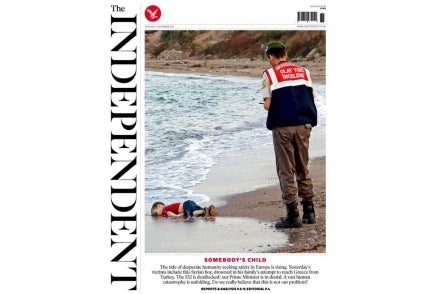
More than 30 complaints have been made about The Independent's Aylan Kurdi front page.
Images of the drowned Syrian boy on a beach featured on several UK newspaper front pages last week.
The majority showed Aylan being carried away from the scene by a police officer. But The Independent opted to show the boy face-down on the beach.
In his column in the newspaper, assistant editor and media editor Ian Burrell revealed that The Independent had received 13 complaints over the front page.
An additional 12 complaints, meanwhile, have been made to the Independent Press Standards Organisation about The Independent's use of the picture.
Because the Evgeny Lebedev-owned title is not regulated by IPSO, however, the complaints will not be considered.
The press regulator has received five complaints – under clause five (intrusion into grief or shock) of the Editors's Code of Practice – about other publications' use of Aylan images and they will be considered.
On the complaints, Burrell wrote: "Some thought it was a cynical gesture to evoke sympathy for refugees, while others were angry that the ambience of their supermarket shop was disturbed by a shocking reminder of human suffering on a distant shore.
"Newspaper readers deserve somewhere trustworthy to take their complaints but that’s not to say that their grievances will always be legitimate ones."
Deputy managing editor Will Gore told Press Gazette that the paper has been "overwhelmed" by support for the decision to publish.
He said: "A small number of people (not necessarily readers) – around 30 – have been in touch to say they disagreed with our decision. We will be responding to all complaints individually in the usual way."
In his column, deputy managing editor Will Gore sought to explain why The Independent chose to publish the Aylan image.
He said: "We published the image online and in print because we believed it was of a different order to pictures we have seen before of the refugee crisis – and was one that might at last lead to action by politicians.
"There was a manifest public interest in showing the horrific reality of human desperation.”
He said: “Of course there are times when the public availability of information online helps us to justify our own use of it: but that cannot be the only consideration.
“Indeed, quite aside from questions of good taste and intrusion, seeing something on social media doesn't make it true.
“Newspapers, ultimately, are curated spaces with editing at their heart. We should not cede the responsibility for making good decisions by simply replicating the free-for-all we can see on Twitter and elsewhere.”
Press Gazette has asked The Independent whether the complaints will be investigated further by the paper and what the process will be.
Elsewhere, The Guardian's deputy production editor Jamie Fahey has also written about his newspaper’s decision to publish the images after at least 12 readers' complaints were made.
He revealed that The Guardian has received “emails from at least a dozen readers, many of whom felt the decision to publish the “disturbing” pictures unpixellated – and alongside, rather than behind, a warning online – was a step too far”.
The pictures appeared on the news wires, he said, at 11.30am, and the decision was taken to publish in the early afternoon.
He quotes Guardian editor-in-chief Katharine Viner as saying: “It was very important to us that we placed Aylan’s death in context, with some serious reporting about what happened to him and the broader picture of current political and social attitudes towards refugees across Europe, particularly in Britain and Germany.
“I still think it was right to use the pictures, but I might be wrong about that, and I’m aware that good intentions and serious intent are not always enough.”
He also quotes Guardian deputy editor Paul Johnson as saying: “We didn’t rush to publish. We verified the photographs and waited for a full story before publication. The enormous poignancy and potential power of the photographs was evident from the start. Could they be the images that provided a tipping point? Would public sympathy, and perhaps anger at Britain’s role as an apparent bystander in this saga, be moved by them? We decided that both of these were highly likely. Those factors had to be balanced again the real shock that some readers would feel.”
Email pged@pressgazette.co.uk to point out mistakes, provide story tips or send in a letter for publication on our "Letters Page" blog
